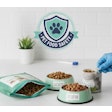These days, pet owners gauge their pet's quality of life based on good health and enjoyment of their food and treats. Rewarding their pets with snacks is perceived to be a way to provide a better quality of life. Thus, treats and snacks are given and consumed in a very different way from complete petfoods (i.e., kibble, wet or semi-moist foods). As a result, methods used to measure the palatability of these products require very specific protocols and criteria.
Specific test protocols
Pet owners often use treats to reinforce their emotional relationship with their animal. Physical contact is an essential part of the reward, and consequently, most snacks are given by hand. To respect this particularity, any palatability testing protocols elaborated require that biscuits or chewy sticks be directly presented to the animals by the technician. In protocols for liquid or paste formula complementary products, the product is placed on the finger or on kibbles.
Since the purpose of a snack is to be accepted by all animals, treats protocols should be set up to measure the product by single acceptability. Monadic tests, in which only one product is given to the dog or the cat, can answer this difficulty. These types of tests are very well tailored for chewing bones such as rawhides or injection-molded products.
Test duration must be defined according to the product type. In order to assess the specific functionality of a treat (for example, a dental care claim for a product that is chewed for a long time) a test should last ten to fifteen minutes per animal, or be adapted to the treat manufacturer's specific duration target.
Specific test criteria
Acceptability is the most important criteria when evaluating treat palatability. Acceptability is defined as the percentage of animals which have taken and totally consumed the product. This specific percentage can provide a precise estimation of the "zero refusal" expected for a treat. Usually, less than 15% of refusals is considered to be well accepted.
Snacks preferences can also be measured using "versus" tests. In this case, specific criteria like the number of animals that have first taken or consumed one of the items are assessed. Animal behavior is key to estimating snack/treat palatability. As pleasure is one of the treat benefits, it is essential to develop criteria used to describe pet behavior while the treat is consumed. Therefore, during the entire test, each animal should be continuously observed according to several behavior patterns. For instance, how the treat is taken or chewed should be analyzed. Does the dog take the snack quickly from the hand? Is the chewing delayed? Does the cat eat slowly and partially finish the treat? All these criteria can much better prove the attractiveness of the treat than solely a consumption ratio.

















